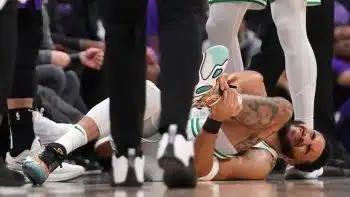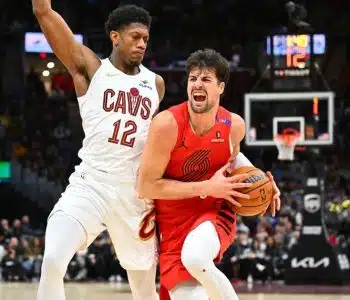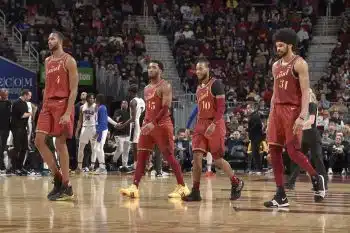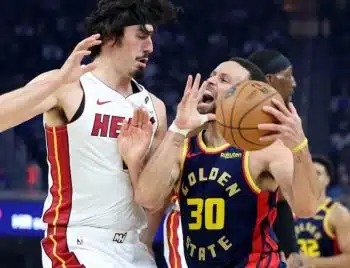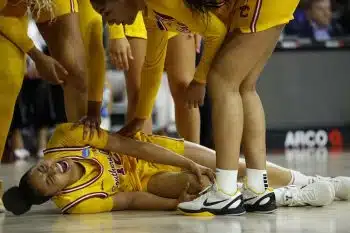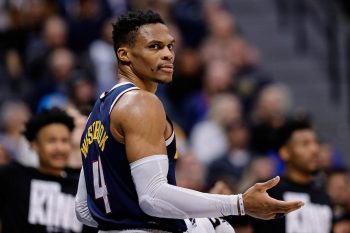NBA
NBA AM: Larkin Needs Opportunity, Stability
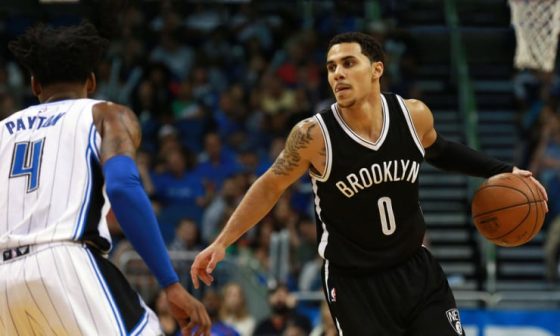
Larkin Needs an Opportunity and Stability
Shane Larkin has played for three teams in his first three seasons in the NBA, and that number could easily become four teams in four seasons depending on what happens this July. That’s because Larkin opted out of the final $1.5 million of his contract, meaning he is an unrestricted free agent.
Larkin, the 18th overall pick in the 2013 NBA Draft, has played for the Dallas Mavericks, New York Knicks and Brooklyn Nets. He signed with Brooklyn last offseason because he loved New York and wanted an opportunity to play. With the Nets, he delivered the best season of his NBA career thus far.
The 23-year-old point guard averaged 7.3 points, 4.4 assists, 2.3 rebounds and 1.2 steals in 22.4 minutes for Brooklyn, and his per-100-possessions numbers were 16.3 points, 9.8 assists, 5.2 rebounds and 2.7 steals. In his 17 games as a starter this season, he averaged 9.5 points, 5.8 assists, 3.4 rebounds and 1.5 steals in 29.4 minutes. Larkin also shot a career-high 44.2 percent from the field and 36.1 percent from three-point range in Brooklyn.
He scored in double-figures 22 times this season and had a number of impressive performances throughout the year. In Brooklyn’s final back-to-back, Larkin was one of the team’s most productive players. He had 15 points, eight assists, four rebounds and one steal against the Indiana Pacers and then followed it up with 20 points (on 9-13 shooting from the field), seven assists and six rebounds against the Washington Wizards the next night. In late March, he led Brooklyn to consecutive wins over the Cleveland Cavaliers (contributing 16 points on 7-10 from the field, seven assists and three rebounds) and the Pacers (recording 14 points on 4-6 from the field, five assists and three steals).
Larkin has opted out of his contract and will be an unrestricted free agent on July 1. He did stress that he loves New York and that he would love to stay with Brooklyn if the franchise wants to grow with him moving forward. But it’s clear that Larkin is seeking stability and, preferably, a long-term home.
“I’m not a guy who wants to play a 10-year career with eight different teams; I want to find a home and really lock in with a team where I know what the coach wants, what my teammates want and we can just all grow together,” Larkin told Basketball Insiders. “I feel like that’s how you get the best out of your players. It’s not like, ‘Alright, let’s get this guy here for a year, he can fill in this void for us and then [move on].’ I just turned 23, so I’m still young. Being able to get with a team on a two-year deal or three-year deal saying, ‘This is what we want you to be. We want you to spark our offense, push the tempo, be this guy and this is what we feel you can do for the team,’ then that’s perfect. Whether I’m a starter or whatever, it’s cool either way. I just want to find a situation where a team wants to see me grow with them and not just [have me as] a fill-in. That’s the kind of situation I’d be looking for.”
The Nets won just 21 games this season, which led to big changes throughout the organization. Head coach Lionel Hollins was fired (Tony Brown became the interim coach) and general manager Billy King was replaced by Sean Marks. Also, the team announced on Sunday that it had hired Atlanta Hawks assistant coach Kenny Atkinson to be its new head coach. The front-office change could impact Larkin’s future since the general manager that signed him is no longer calling the shots. The coaching change affected him as well and he had to make a difficult midseason adjustment.
“It’s tough, especially as a point guard because you’re an extension of the coach on the floor,” Larkin said. “I mean, at the beginning of the year, there were several articles saying, ‘Oh, it’s Larkin’s breakout year, he’s finally found himself, averaging this and that, shooting well from the three.’ I was really comfortable with Coach Hollins. But after 37 games, to be exact, Coach Hollins was out of here and Billy King was released or whatever it was so it was like we didn’t really have a lot of direction. Coach Tony was kind of just handed the job like, ‘Alright, here you go.’ It was kind of like, ‘Just like go play basketball.’ [Until mid-February], there was no GM telling him who he wants to be played, what he wants to do. It changes everything because there’s no real direction. There’s no, ‘Oh, let’s play the young guys in this type of system.’ It’s kind of just like, ‘Okay, here’s the guys you have – go out and try to win basketball games.’ I mean, that’s tough. Coach Tony wanted to change some things up, whether it’s not running as many pick-and-rolls or playing more up-tempo, post feeds, cuts, stuff like that.
“It’s just difficult, when I’ve now been with four coaches in three years. It’s definitely easier when you’re with a team for a while and you know what your coach wants and you know what he expects from you. He knows what you can do, he knows the pros and cons to your game and he could put you in a position to be successful. So not really being able to be in that type of situation is difficult. But at the same time, I’m learning [from each coach], just like I did with the Triangle in New York and the system in Dallas. When I do get to a situation where I’m comfortable, all those things will help me be a better player. It’s tough, but I just have to keep working. No excuses.”
On the other hand, there are some positives that come with playing for so many coaches. Larkin has gotten the chance to pick the brain of Rick Carlisle, Derek Fisher, Hollins and Brown, while learning to play differently for each of them.
“You can see the chemistry that Brook [Lopez] and I have with the back-door cuts and everything, and I learned that from the Triangle,” Larkin said. “Before that – my rookie year in Dallas – I didn’t really have that knowledge of how to cut off the post and what not, but the Triangle taught me that. For whatever reason, some people don’t like the Triangle, but it really helped me in terms of playing off of the post. So I’ll throw it into Brook, make my read off the post and me and him are really deadly in that when he’s dropping it off to me when I’m cutting to the basket. I’d say that helped me this year. It helped me take another step up, progressing in the pick-and-roll, learning when to drop the pocket pass, when to feed the big, when to shoot the pull-up. I’ve just been progressing every single year.”
While this past year was certainly frustrating at times, Larkin is remaining positive and looking for lessons from the campaign. He acknowledges that he still has a lot of room for growth, but did say that he grew as a player during his third NBA season.
“I’ve learned a lot,” Larkin said. “This is really my first year being in the pick-and-roll system since my rookie year, but I missed half of that with a broken ankle. So it’s just been a progression on reads, what I should be looking for when we are in the single eye, double eye and just being patient in the pick-and-roll. That was something that Coach Hollins was really preaching to me at the beginning of the year: making the right reads, the pick-and-roll, defensively what I need to do more of and things like that. The more you play, the more experience you gain. Overall, I’ve learned a lot this year.”
When players enter the NBA out of college, they’re often asked what NBA players they study. Well, as a point guard, Larkin spends most evenings playing against some of the best basketball players on the planet since there are so many stars at his position. When asked which players he has learned from since being in the league and who he tries to model his game after, Larkin mainly focused on Los Angeles Clippers floor general Chris Paul.
“Every time Chris Paul plays, I try to watch him just because he’s masterful in the pick-and-roll,” Larkin said. “There are certain guys you can’t really watch and play like, you know? You see Steph Curry and you can’t do Steph Curry stuff. You can’t do what Russell Westbrook does because he’s 6’4 and he beats everybody off the dribble. CP is my size, he’s not the quickest guy in the league and he just plays with a nice pace to his game. He always sets his man up, gets in the lane, knows when to throw the lob, when to throw the pocket pass and he just knows where all his people are on the court. I would say he’s somebody that I really watch a lot. [Shooting coach] David Nurse sends me clips of him constantly. Steve Nash is another guy I get sent clips of often. Those are the guys that I watch and try to learn from.”
While Larkin’s career hasn’t gotten off to the start that many expected, it’s important to note that he has improved each year and played well when put in position to succeed. Sometimes, it takes some time before a player is given a great opportunity or put in the perfect situation
It wasn’t until Chauncey Billups was in his sixth season (and on his fifth team, the Detroit Pistons) that he became a full-time starter and thrived.
Or take Kyle Lowry, for example. It took several years and changes of scenery before he became the perennial All-Star everyone knows today. Now that Lowry is a star, it’s easy to forget that he didn’t become a starter until his fifth season in the NBA and wasn’t an All-Star until he was 28 years old and in his ninth year in the league.
Larkin looks at Billups’ and Lowry’s journeys and hopes he can have a similar path to success after bouncing around the league during his first three seasons.
“A lot of the NBA is about your situation,” Larkin said. “Kyle Lowry was in Memphis his first couple years and he wasn’t playing bad, but he was a back-up with solid numbers like eight or nine points a game and a couple assists. Then, he went to Houston, started there and then it was 12 or 13 points a game, not really killing it. But then he got to Toronto and he’s taking off now. He’s been an All-Star two years in a row and he’s one of the best point guards in the league.
“It’s just progression. It’s about work ethic and finding the right situation. That’s really all it’s about. You just have to get to a situation where the team really wants you to progress and excel so you can go far with the team and grow with them. I feel like I can do that. It’s possible – you just have to keep working, keep getting better and just find the right situation.”
